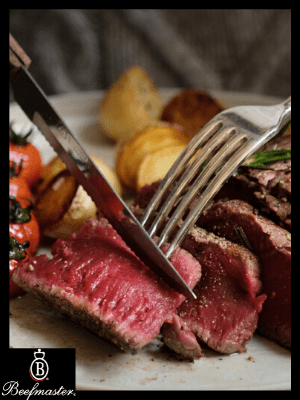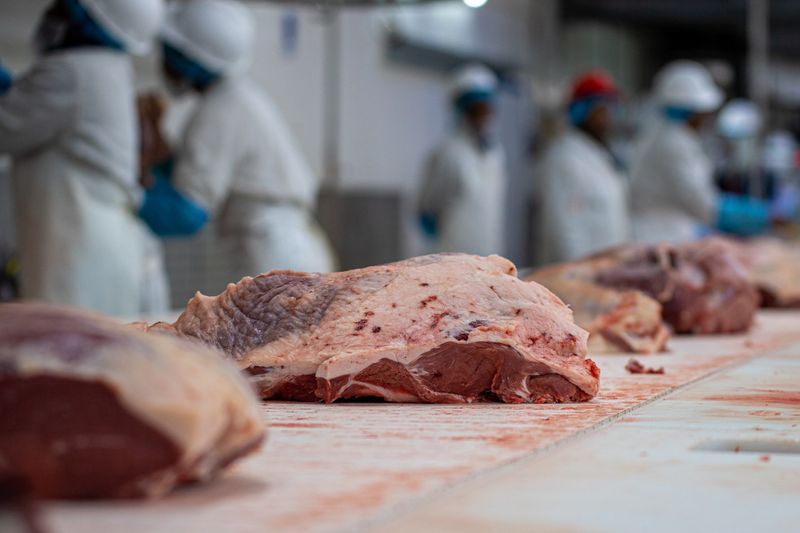 If you’ve ever wondered how your beef products are handled and processed before they arrive on your plate, you’ve come to the right place.
If you’ve ever wondered how your beef products are handled and processed before they arrive on your plate, you’ve come to the right place.
While Beefmaster maintains the absolute highest standards of quality and compassion in the treatment of our cattle, and the highest standards of occupational and consumer health and safety when it comes to the processing of our beef, this isn’t the case in all abattoirs – which is why exceptional quality Beefmaster beef products are in such high demand the world over!
To learn more about modern meat processing practices, the latest technologies, and the Beefmaster way, just keep reading!
From Farm to Table
Meat processing operations are divided into three distinct stages: preslaughter handling, stunning, and slaughtering.
Preslaughter handling is an integral part of the meat processing operation, and failure to follow proper procedure and preslaughter handling practices can have dire consequences on the quality of the final meat products.
This is because animals who experience stress and secrete stress hormones prior to slaughter produce tough and/or otherwise subpar meat products.
This is especially true of pork products, which are prone to postmortem quality problems.
In order to reduce the stress on livestock, and to improve the quality of the beef products produced, animals should be kept isolated from other species, as well as at a reasonable distance from the slaughter site.
Cattle should also be kept cool, and in well ventilated areas which are not to be overcrowded.
During this preslaughter period, animals should be given free access to water, but should be nil per mouth for 12-24hrs prior to slaughter to ensure complete bleeding and aid in the efficiency of the evisceration processes post-slaughter.
While most meat processing facilities and abattoirs practice stunning in one form or another, not all methods are created equal, nor are all of them allowed by the various regulatory bodies which dictate the awarding of certifications like, for example, a Halal meat certification.

Methods of stunning used today are primarily mechanical, electrical, or gaseous.
Mechanical stunning involves firing a bolt into the brainstem of the animal using a pistol or pneumatic device.
Electrical stunning involves passing an electrical current through the animal’s brain, and gaseous stunning involves exposing the animal to a mixture of carbon dioxide gas, which is believed to have an anesthetic effect.
Those who champion stunning in the meat processing operation do so as it is believed to ensure a humane end with minimal pain and suffering.
Stunning also contributes to improved meat quality as it reduces stress in the musculature of the animal prior to slaughter.
Just as not all stunning methods are created equal, nor are all methods of slaughter.
If a meat processor hopes to attain specific certifications, for example, they may have to conform to certain slaughtering procedures.
For example, Halal meat processing requires that no individual animal witness the death of another, so as not to cause the animals undue distress.
However, certain methods of slaughter are far more cost efficient than others, and so meat processing operations always weigh the cost of processing against the quality of the product.
At Beefmaster, we don’t cut corners.
You can rest assured that our exceptional quality beef products are born of our exceptional care and attention to detail in every phase of the meat processing operation.
Once slaughtered, animals are bled or exsanguinated (drained of blood) and are then skinned – either by hand in small-scale operations, or mechanically, with the assistance of hide-pullers, in large-scale operations.
Also read – Cattle Farming – All You’ve Ever Wanted to Know About
Processing & Portioning
Once the hides have been removed, heads are removed at the first cervical vertebrae and the carcasses are eviscerated.
In beef production the evisceration is not complete and the kidney, pelvic and heart fats are typically left behind for grading purposes.
The carcass is then chilled for approximately 48hrs before further processing and portioning begin.
After two days of chilling, the carcasses are processed first into their major (primal) cuts, and then into their minor (subprimal) cuts.
Both primal and subprimal cuts can be further processed into the finished products you’d expect to find in the supermarket fridge.
Examples include beef mince, steak strips, deboned ribs, fillet steak etc.
On average, about 63% of the live weight of the cattle is processed into beef products, and the primary wholesale cuts include the chuck, the brisket, the foreshank, rib and shortplate, which are all produced from the forequarters; as well as the short loin, sirloin, rump, round and flank from the hindquarters.
Here at Beefmaster, we supply not only wholesale cuts, but also custom packaged as well as deboned cuts according to our individual customers’ specifications.
Our state of the art portioning and packing facility allows us to supply both retailers and wholesalers across the globe with exceptional quality beef products, tailor-prepped to their exact specifications.
Also read – A Tour Of The Beefmaster Group Feedlot
Meat Processing Facilities & Technologies

The most important meat processing facility is your cold storage facility.
Mass refrigeration is, however, only the first in a series of steps that can be taken to prolong meat shelf-life.
Other steps may include vacuum packing, canning, fermenting, drying, curing or smoking, or, perhaps most commonly, freezing.
While freezing has always been a great way to preserve meat and prevent spoilage, breakthroughs in technology mean no-longer having to rely on slow-freezing to preserve meat.
Slow-freezing causes large ice crystals to form in the muscle fibre of the meat products, leading to issues of flavour-loss and wateriness upon defrosting.
To avoid these pitfalls of slow-freezing, flash-freezing methods have become more and more popular as the technology has become more readily available and affordable.
Flash-freezing methods may include the use of chemical agents, like liquid nitrogen, to freeze products as quickly as possible.
However, sometimes the thawing process can be even more detrimental to meat quality than slow-freezing, and so, one of the more popular methods of preserving fresh (unfrozen) meat remains vacuum packing.
Because bacteria requires oxygen to grow, vacuum packing our beef products and depriving the environment of oxygen effectively extends the refrigerated shelf-life of Beefmaster beef products to approximately 100 days!
Other common meat processing technologies include the most popular meat processing machines, which can be either manual (in smaller-scale operations) or automatic (in large-scale processing facilities).
These machines include, but are not limited to:
- A meat timber: these machines are available in manual and automatic varieties and are used to cut wholesale meat portions. It is one of the most important machines in any commercial meat processing facility. It has sharp blades and teeth, perfect for cutting through tough gristle and bone as needed.
- A standard meat grinder: this machine can be used for cutting, dicing, mincing, and otherwise reducing the size of individual meat fragments or portions for preparation prior to consumption. A commercial meat grinder can handle harder and softer meats including beef, chicken, lamb etc. Meat grinders are no longer limited to the commercial setting, and many people have their own hand-operated meat grinders in their own homes for the production of artisanal mince meats and sausages etc.
For more information on our operations, you can view an overview of each phase, or explore each aspect of our operations in-depth
Occupational & Consumer Healthy and Safety
HIstorically, meat processing facilities have often been sites of occupational health and safety hazards, and Beefmaster is committed to exceeding expectations of both occupational and consumer health and safety.
By law, it is every meat processing facility’s responsibility to have a Preventative Control Plan (PCP) in place, which dictates the regulations and procedures to be followed to ensure the health and safety of both industry workers and consumers.

Our PCP goes above and beyond the legal requirements mandated by government and the relevant industry standards, and covers:
- The maintenance and management of our physical facilities in such a manner as to minimise health and safety risks to personnel, and minimise the risk of product contamination.
- The maintenance and management of our transportation fleet to ensure the health and safety of our fleet personnel as well as the health and safety of our consumers on the receiving end of goods transported.
- The maintenance and supervised use of our facility equipment by trained professionals to ensure the minimization of risk to the health and safety of equipment operators, and to ensure the health and safety of our consumers by preventing contamination threats.
- A sanitation and pest control plan geared toward preventing any possible product contamination or health and safety risk to facility personnel.
- An established recall program in the event of an unavoidable health and safety risk being posed by our products despite these aforementioned measures taken to minimise said risks.
- Maintaining records and monitoring all facility activity in an effort to identify and address potential health and safety threats before they arise.
Learn more about Regulation of Food Safety and Quality in South Africa
In addition to these preventative measures, Beefmaster is committed to complying with all relevant legislation pertaining to the safe slaughter, processing, portioning, packing and transportation of our beef products.
All our employees maintain rigorous personal hygiene standards while on the job, our facilities management team takes great pride in exceeding mandated standards of cleanliness, and waste management, and our consumers enjoy being able to rest assured that their health and safety is a top Beefmaster priority!
For more information on what sets us apart, feel free to browse the rest of website and article content to learn more about our involvement in the beef industry from farm to table!
To find out more about The Beefmaster Group, where you can purchase your Beefmaster beef products, or how we run our business, please feel free to explore our website further.
If you have any specific questions, we’d love to hear from you!
For general enquiries, you can contact us.
Otherwise, give us a call at any of our retail outlets for product-related information.





